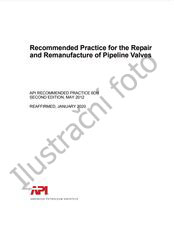Potřebujeme váš souhlas k využití jednotlivých dat, aby se vám mimo jiné mohly ukazovat informace týkající se vašich zájmů. Souhlas udělíte kliknutím na tlačítko „OK“.

API TR 6F1-ed.3
Technical Report on Performance of API and ANSI End Connections in a Fire Test According to API Specification 6FA
Přeložit název
NORMA vydána dne 1.4.1999
Informace o normě:
Označení normy: API TR 6F1-ed.3
Datum vydání normy: 1.4.1999
Kód zboží: NS-1140748
Počet stran: 42
Přibližná hmotnost: 126 g (0.28 liber)
Země: Americká technická norma
Kategorie: Technické normy API
Anotace textu normy API TR 6F1-ed.3 :
API TR 6F1, 3rd Edition, April 1999 - Technical Report on Performance of API and ANSI End Connections in a Fire Test According to API Specification 6FA
1 Scope and Applicability
The sizes of interest are shown in Table 1. The ANSI (8) sizes are adopted by API Spec 6D. The API sizes refer to those in API Spec 6A.
Table 2 shows the materials and gasket types which have been studied. As can be seen, there are a large number of sizes and combinations of materials and gaskets.
One very important point is that this Technical Report, and the research projects which preceded it, are based on the fire test procedure in API Spec 6FA. Whether or not API Spec 6FA adequately defines a "true" fire is totally outside the scope of this bulletin. The test simulates a closed condition with no flow through the connection. If there were flow through the connector, the heat transfer response would likely be different. Also, the external loads from dead weight, piping system thermal expansion, wind, etc., could significantly affect a joints performance in a fire. These effects could be included in the design procedures reported herein, but they are not in the scope of this report.
1.1 EFFECTS OF FIRE ENVIRONMENT
Exposure to a fire environment around a flanged or clamped joint will tend to reduce the joint preload required for many seals to function. In a flanged joint, the flange exterior and bolts will heat up quicker than the seal and interior flange portion. This thermal gradient across the joint will cause preload to be lost. If enough preload is lost, the seal may unseat and leak; lose the contact pressure necessary to maintain a seal; fail if the seal is not strong enough to carry pressure load without the restraint from the adjacent contact surfaces, or fail if the temperature capacity of the seal material is exceeded.
1.1.1 In addition to preload loss from the thermal gradient, there is a preload loss due to the reduction of joint stiffness resulting from increasing temperature. Another factor which can cause preload loss is yielding of the gaskets, studs, or flanges. Bolt yielding results in permanent stretching which means permanent preload loss and likely leakage, either hot or cold.
1.2 SIGNIFICANT VARIABLES
Variables which are significant to this problem are as follows:
- 1.2.1 Size and Geometry of the Joint
The size will greatly affect the thermal gradient through the joint, with larger joints having much larger thermal gradient than smaller joints for a thermal event such as the standard API Fire Test. However, the larger joints do not get nearly as hot as the smaller joints for the fire test conditions of this Technical Report. Figures 1 and 2 illustrate this.
1.2.2 Type of Seal
Of particular importance for the seals is the seating load, the retaining load; amount of pressure energization; whether the seal is used in joints that make up face-to-face, or with standoff; and the gasket material.
1.2.3 Material of Construction
Carbon steel has a thermal conductivity approximately three times as large as that of austenitic stainless steel, and a lower thermal expansion coefficient. Thus, the thermal response and preload change of the joints are a very strong function of the material.
In addition, a critical variable is the yield strength of the bolts and flange at the high temperature of the test. If a large amount of yielding occurs, the remaining preload will be very small.
1.2.4 Joint Preloads and Internal Pressures
Flanged and clamped joints are normally designed with preloads based on two considerations: (a) the amount of preload required to seat the seal, and (b) the amount of preload required for the gasket retaining load, pressure end loads, and any external forces or moments. Joints in which the seating load is controlling (highest) will tend to have more preload margin for the pressure and retaining load case and, thus, may tend to be more leak resistant in the fire test. Further, the API Fire Test is at about 75% of the rated pressure. For high pressure connections, this 75% of rated pressure is a very large number compared to the retaining load. Thus, it might be expected that higher pressure joints are more resistant to the fire.
Another consideration is the variability of preload in actual field joints.
Doporučujeme:
Aktualizace zákonů
Chcete mít jistotu o platnosti užívaných předpisů?
Nabízíme Vám řešení, abyste mohli používat stále platné (aktuální) legislativní předpisy.
Chcete vědět více informací? Podívejte se na tuto stránku.



 Cookies
Cookies
